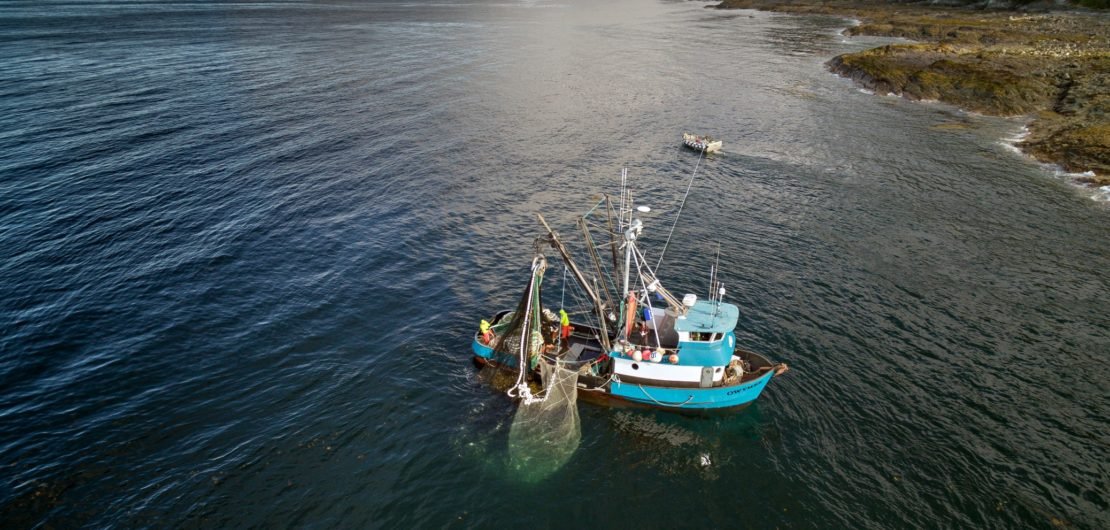Working for free: What’s the dollar value of wild salmon produced by the Tongass and the Chugach?
A seiner harvests salmon in the waters surrounding Southeast Alaska’s Tongass National Forest. On average, commercial fishermen catch an average of 48 million salmon born in the Tongass and the Chugach National Forests each year, for an annual average dockside value of $88 million. Scientists recently quantified the commercial value of Alaska’s “forest fish” for the first time. Photo by Chris Miller/csmphotos.com
Clean air. Clean water. Deer. Moose. Blueberries. Salmon.
Alaska’s Tongass and Chugach National Forests provide many different things to the people who rely on them for food, recreation or a living, but because the forests work for free, the value of the services they provide is sometimes hard to recognize. As part of a growing movement to figure out the dollar value of those forest “products,” however, scientists for the first time have estimated the value of the Tongass and the Chugach National Forests to Alaska’s commercial salmon industry.
The short version of their findings: the forests contribute a lot, and even that is a known underestimate.
Combined, wild salmon born within the boundaries of the Tongass and the Chugach average a quarter of Alaska’s commercial Pacific salmon catch and 16 percent of the total commercial value of salmon caught in Alaska each year. For the 10-year study period, Alaska commercial fishermen caught an average 48 million “forest salmon” each year. All together, those forest salmon’s annual dockside value averaged $88 million.
“One of the things that the Forest Service is interested in doing is estimating the value of the different activities and services that national forests provide,” said study co-author, research fish biologist J. Ryan Bellmore. “And the Tongass and the Chugach provide a lot of salmon.”
Bellmore and hydrologist Adelaide C. Johnson were lead co-authors on the study, “Quantifying the Monetary Value of Alaska National Forests to Commercial Pacific Salmon Fisheries,” recently published in the North American Journal of Fisheries Management.
A seiner harvests salmon in the waters surrounding Southeast Alaska’s Tongass National Forest. Photo by Chris Miller/csmphotos.com
Figuring out the value of “forest fish”
This is the first time anyone has attempted to quantify what the Tongass and the Chugach National Forests, specifically, contribute to the commercial fishing economy. In order to do it, the authors excluded salmon born outside the streams, rivers and lakes within Tongass and the Chugach National Forest boundaries, like the Canadian portions of the transboundary Taku, Stikine and Unuk Rivers, state land, private land, and Native corporation land. They also of course, excluded hatchery-produced fish.
Even focusing on commercial salmon, the number “is actually a significant underestimate of the value of national forests to salmon fisheries,” said Bellmore. “Chinook salmon are a perfect example. Many Chinook in this region spawn in transboundary rivers upstream of national forests, but juveniles eventually migrate downstream, and can be supported by habitat and food webs within national forests boundaries.”
The same is true, Johnson pointed out, for the importance of the Chugach National Forest to the Copper River.
The study also underestimates the value of salmon produced by the forest, the authors said, as it only takes into account commercial harvest — not recreational, subsistence, cultural, etc. Finally, it counts only dockside value, not, for example, the economic impact of local fish processing.
Still, it’s a start to have commercial dockside value of salmon produced by the Tongass and the Chugach quantified and isolated.
“Suffice to say, there’s still a lot of work to do,” Bellmore said.
Management decisions
The U.S. Forest Service until December 17, 2019 took comment on a proposed removal of Roadless Rule protections for more than 9 million acres of the Tongass National Forest, which would open up currently protected areas for logging roads, clearcuts, and industrial development. The study could inform current decision-making, but the scientists declined to comment on the study’s relevance to a specific management decision.
“It’s a goal to be doing relevant research,” Johnson said.
Still, the study acknowledges the role that sometimes competing resources have played in the decline of salmon across the West Coast.
“Within a century of European colonization many of these runs (in the Pacific Northwest) were critically imperiled, due in part to logging activities that deteriorated freshwater spawning and rearing habitat. This legacy of forest management—combined with dam construction, overharvest, mining and urbanization—has resulted in billions spent on hatcheries and other restoration actions aimed at maintaining recreational, commercial, and subsistence fisheries that were once provided by intact ecosystems,” reads the study. In spite of modern practices meant to address these kinds of impacts, like stream buffers, “strong economic pressures still exist that may be at odds with maintaining healthy Pacific salmon habitat, such as intensive timber harvest, mining, and urbanization.”
Ultimately, the study authors indicate that their findings can be used in informing forest management.
“We provide this information, and it’s up to society to decide what decisions we make,” Bellmore said.
Studying the monetary value of these “free” products allows managers to better anticipate what the cost to society would be if the forest no longer provided those free services.
“Different river systems produce fish in different ways and at different times,” Bellmore said. “If you have a diversity of habitats that are productive at different times, that’s really important in a place like Southeast Alaska, that is changing rapidly…. We may have more adaptive capacity than other places in the world because we still have a lot of intact land.”


